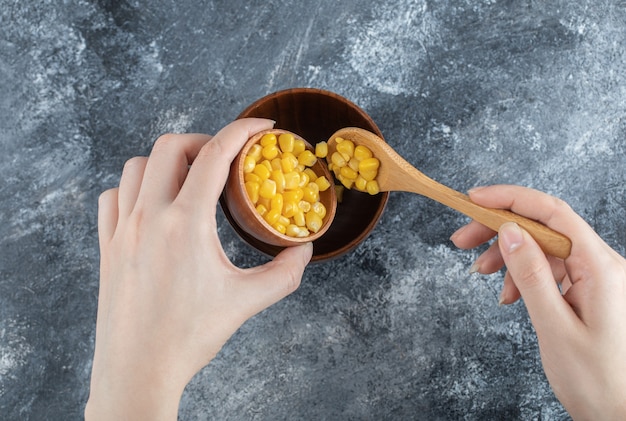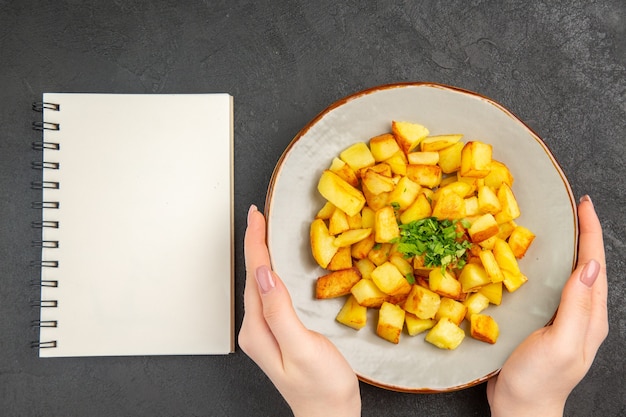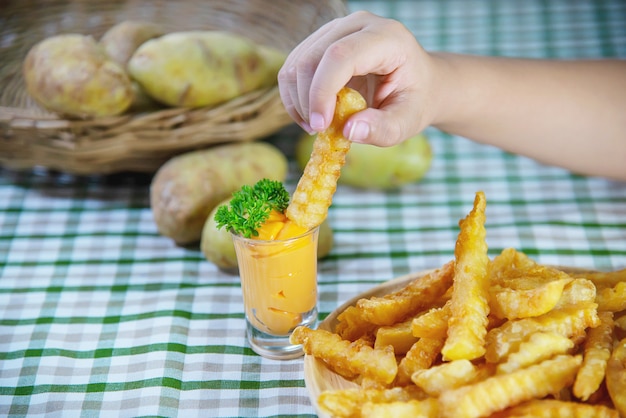Let’s face it, we all have a soft spot for a good chip, right? A classic side dish that can turn any meal into a symphony of flavours. It’s not just the taste, though. It’s that satisfying crunch, the perfect bite that makes you say, “Ah, yes, that’s the stuff!”
But achieving that perfect fry is a bit like a culinary dance. You need the right ingredients, the right temperature, and a knack for timing. Over the years, I’ve experimented with various methods, from oven fries to air fryer creations. But for me, nothing beats the magic of good old-fashioned grease. It’s the key to unlocking that deep-fried flavour that simply cannot be replicated.
Deep-frying can seem daunting at first, I get it. But with the right approach, it’s actually quite simple and incredibly rewarding. Through years of experimentation (and a few soggy disasters along the way), I’ve finally cracked the code to the perfect crispy fry. And I’m going to share all my secrets with you.
So, grab your frying pan and get ready to embark on a journey of crispy goodness! We’ll dive into the world of grease, explore the art of deep-frying, and uncover the hidden secrets to making those irresistibly crunchy fries. We’re going for the ultimate satisfaction, my friend!
(Part 1) The Grease Factor

Alright, let’s address the elephant in the room: the grease. It might seem intimidating, but it’s actually a key player in this delicious game. It’s not just about any old oil, though. We’re looking for something that can handle the heat, deliver that signature crispy bite, and create a truly satisfying fry experience.
1.1 Choosing the Right Oil
When it comes to frying, you’ve got options, my friend! From classic vegetable oil to the more sophisticated peanut oil, the choice is yours. But let’s talk about the best options for deep-frying those perfect fries:
- Vegetable Oil: The go-to for many, and for good reason. It’s budget-friendly, has a neutral flavour, and can handle high temperatures. Perfect for everyday frying, but you might not get that extra-crispy edge you’re looking for.
- Peanut Oil: Now we’re talking! Peanut oil has a higher smoke point than vegetable oil, meaning it can withstand hotter temperatures without breaking down. It also adds a hint of nutty flavour that many find irresistible. My personal favourite for deep-frying.
- canola oil: Similar to vegetable oil, canola oil is a good choice. It’s got a high smoke point and a neutral flavour. It’s a bit pricier, but worth considering if you’re looking for a healthier option.
- Olive Oil: Amazing for drizzling and salads, but not your best friend when it comes to deep-frying. It has a low smoke point and a strong flavour that can overpower your fries. Save it for those gourmet dishes!
The main thing to remember is to choose an oil with a high smoke point. This ensures it can withstand the heat without burning or releasing harmful compounds. You want your oil to be hot enough to cook those fries through, creating that crispy exterior without turning them into a charred mess.
1.2 The Importance of Fresh Oil
This might seem obvious, but using fresh oil is absolutely essential! That stale oil from last week’s fish and chips is not going to do your fries any favours. Use fresh oil every time, and if you’re using it multiple times, make sure to filter it after each use. This removes any food particles that could burn and affect the flavour.
And here’s a little tip: If you want to get the most out of your oil, use a dedicated frying pan. This prevents the oil from absorbing flavours from other dishes, keeping it clean and ready to give your fries the best possible start.
(Part 2) Mastering the Art of Deep-Frying

Alright, now that we’ve got our grease sorted, let’s get down to the nitty-gritty! Deep-frying is all about control and precision. It’s not just tossing potatoes into a pan of hot oil and hoping for the best. There are techniques and tricks to master that will help you achieve that perfect crispy perfection we’re all craving.
2.1 The Perfect Temperature
One of the most crucial factors in deep-frying is temperature. You need that oil nice and hot, but not too hot! Think of it as a delicate dance, a balance between heat and precision.
The ideal temperature for frying potatoes is between 175°C and 190°C (350°F and 375°F). Too low, and your fries will absorb too much oil, resulting in a soggy mess. Too high, and you’ll end up with burnt offerings!
Now, I know what you’re thinking: “How on earth do I know if my oil is the right temperature?” Don’t worry, there are a few handy tricks you can use:
- The Breadcrumb Test: Drop a tiny crumb of bread into the oil. If it sizzles and browns within a few seconds, you’re good to go. If it takes longer or just sits there, your oil isn’t hot enough.
- The Thermometer: This is the most accurate method. Use a kitchen thermometer to check the temperature of the oil. It should be within the ideal range we discussed earlier.
Once you’ve reached the desired temperature, you’re ready to start frying. But hold your horses, we’re not done yet!
2.2 Preparing Your Potatoes
Achieving that perfect fry starts with the preparation. This isn’t just about chopping potatoes, it’s about creating the right foundation for those crispy beauties. It’s all about those subtle steps that make a world of difference.
2.2.1 choosing the right potato
Not all potatoes are created equal, my friend. Some are better suited for baking, while others are perfect for frying. For those crispy fries, you want a potato that’s starchy and high in moisture. Here are a few favourites:
- maris piper: A classic for chips, Maris Piper potatoes are known for their fluffy texture and good flavour.
- king edward: Another popular choice, king edward potatoes are also starchy and have a delightful flavour.
- Desiree: If you’re looking for a potato with a bit more bite, Desiree is a good option, offering a lovely waxy texture.
Avoid potatoes that are too starchy, as they can become crumbly when fried. And steer clear of waxy potatoes, as they’ll hold on to too much moisture and won’t achieve that crispy exterior.
2.2.2 The Cut
It’s all about the cut, my friend. A thin, even cut will ensure your fries cook evenly and achieve that golden-brown perfection. Aim for fries that are about 1/2 inch thick and 3 inches long. You can experiment with different shapes and sizes, but consistency is key!
2.2.3 The Soak
This is where things get interesting. Soaking your potatoes in cold water for at least 30 minutes before frying is a crucial step. Why? Because it helps to remove excess starch. Starch is the enemy of crispy fries! By removing some of the starch, you’ll prevent your fries from becoming soggy and help them achieve that golden-brown crunch.
2.2.4 Drying is Essential
Once you’ve soaked your potatoes, drying them thoroughly is essential. You can pat them dry with a clean kitchen towel or give them a good shake. The goal is to remove as much moisture as possible. Why? Because moisture leads to steam, and steam is the enemy of crispy fries!
2.3 The Frying Process
Alright, so your oil is hot, your potatoes are prepped, and you’re ready to rock! But before you dive in, remember, this is a two-stage process. We’re going for that perfect combination of crispy exterior and fluffy interior.
2.3.1 The First Fry
This is the crucial step that sets the foundation for those crispy beauties. Here’s how it works:
- Batch It Up: Don’t overcrowd your pan. Add enough potatoes to cover the bottom of the pan in a single layer, but not so many that they start to crowd each other.
- Low and Slow: You want to cook the potatoes gently in the first fry. This is about achieving a golden colour and developing those crispy edges. It typically takes about 3-5 minutes. But don’t just leave them there and forget about them! You need to keep an eye on them and make sure they’re not burning.
- The Flip: Once they’ve developed a nice golden colour, gently flip those potatoes over. Let the other side cook for another 3-5 minutes until it’s golden brown as well.
- Remove and Drain: When both sides are golden, carefully remove the fries from the oil and place them on a wire rack to drain. This will help to prevent them from becoming soggy.
2.3.2 The Second Fry
Now, you’re ready for the grand finale. This is where you crank up the heat and get those fries really crispy. It’s all about creating that satisfying crunch!
- Heat It Up: Bring your oil back up to temperature, aiming for 190°C (375°F).
- Back in the Game: Carefully add your pre-fried potatoes back to the hot oil.
- Quick and Crispy: Cook for about 2-3 minutes, or until they’re golden brown and crispy. This is a quick process, so keep a close eye on those fries! You don’t want them to burn.
- Remove and Enjoy: Remove those beauties from the hot oil and let them drain on a wire rack.
2.4 The Finishing Touches
You’re almost there, my friend! Your fries are crispy, golden, and looking delicious. But hold your horses, we’re not done yet. We need to add those final touches to take your fries to the next level.
2.4.1 Salt, Salt, Salt!
Let’s face it, salt is a must for fries. It brings out the flavour and makes those crispy beauties truly irresistible. But here’s the thing: don’t salt your fries while they’re still hot. Why? Because the salt will absorb the moisture, making your fries soggy. Instead, salt them after they’ve cooled down a bit. This way, they’ll stay crispy and delicious.
2.4.2 A Sprinkle of Magic
Now, this is where you can get creative. Add a sprinkle of paprika, a dusting of garlic powder, or a touch of your favourite spice blend. It’s all about adding those finishing touches that make your fries unique and unforgettable.
2.4.3 The Dipping Delights
And of course, what are fries without a delicious dipping sauce? Whether you prefer ketchup, mayonnaise, or something a bit more adventurous, a dipping sauce is a must for any fry lover. So, gather your favourite sauces and get ready to enjoy your crispy, golden masterpiece.
(Part 3) FAQs

I’m sure you’re probably wondering about a few things. So, let’s tackle some of the most frequently asked questions about deep-frying and achieving that perfect crispy fry.
3.1 Can I Re-Use Frying Oil?
Yes, you can reuse frying oil a few times, but it’s important to filter it after each use. This will help to remove any food particles that could start to burn and affect the flavour. However, I recommend replacing the oil after 3-4 uses. Once it starts to become dark and cloudy, it’s time for a fresh batch.
3.2 How Can I Prevent My Fries From Getting Soggy?
Remember those soaking and drying steps we talked about? They’re crucial for preventing soggy fries. If you’re still having problems, try drying your fries on a wire rack after they’ve been fried. This will help to allow the excess oil to drain away, preventing them from becoming soggy.
3.3 What Should I Do If My Fries Are Too Soft?
If your fries are too soft, it’s likely that they weren’t cooked long enough in the second fry. Try increasing the cooking time by a minute or two, or even give them a second round in the hot oil. Remember, patience is key to achieving that perfect crunch!
3.4 What’s The Best Way to Store Leftover Fries?
Honestly, leftover fries are rarely a problem in my house! But if you happen to have some, it’s best to store them in an airtight container at room temperature. They’ll stay crispy for a few hours. If you’re storing them for longer, you can refrigerate them. However, keep in mind that they might lose some of their crispiness.
3.5 How Can I Get Creative with My Fries?
The world of fries is your oyster! Experiment with different flavour combinations, toppings, and dipping sauces. Add a sprinkle of cheese, a drizzle of hot sauce, or a dollop of sour cream. The possibilities are endless!
(Part 4) Beyond the Basics
Now that we’ve covered the fundamentals, let’s explore some creative ways to elevate your fry game and impress your friends and family with your culinary skills.
4.1 Taking it to the Next Level
If you’re looking to elevate your fry experience, consider these advanced techniques:
4.1.1 The Double-Fry
We already touched on the importance of a second fry for achieving that perfect crunch. But what if I told you that you could double-fry those beauties? That’s right, you can give them a second bath in hot oil after they’ve already been fried. This will result in even crispier fries with an irresistible texture. Just be careful not to overcook them!
4.1.2 The Herb and Spice Infusion
Want to add a touch of sophistication to your fries? Try adding herbs and spices to your frying oil. Think rosemary, thyme, garlic, or even a pinch of chilli flakes. It’ll infuse your fries with a flavour that’s sure to impress.
4.1.3 The Waffle Fry Revolution
For a change of pace, try making waffle fries. These beauties are perfect for dipping and have a unique, crispy texture. You can make them at home with a waffle iron or grab a bag of pre-cut fries from your local grocery store.
(Part 5) Safety First
Deep-frying is a fun and rewarding experience, but safety is paramount. Here are a few tips to keep in mind when working with hot oil:
- Never leave hot oil unattended: Keep a close eye on your oil while it’s hot. It can quickly ignite if it gets too hot.
- Use a deep-frying thermometer: This will help you monitor the temperature of your oil and ensure it’s at the right level for safe frying.
- Never pour hot oil down the drain: This can cause clogs and damage your plumbing. Allow it to cool down and then dispose of it properly.
- Use a deep-frying pan with a lid: In case of a fire, the lid will help to smother the flames and prevent them from spreading.
- Keep a fire extinguisher nearby: Just in case! It’s always a good idea to have one on hand when you’re working with hot oil.
(Part 6) A Word on Health
I know, deep-frying isn’t exactly the healthiest cooking method out there. But that doesn’t mean you have to give up your favourite crispy fries entirely. Here are a few tips for making healthier choices:
- Choose a healthy oil: Opt for a heart-healthy oil like olive oil or canola oil.
- Don’t overcrowd the pan: This will help prevent the oil from cooling down too much, reducing the amount of oil absorbed by your fries.
- Drain your fries well: This will help to reduce the fat content of your fries.
- Don’t overcook: Overcooked fries absorb more oil.
- Enjoy in moderation: Like anything, fries should be enjoyed in moderation as part of a balanced diet.
(Part 7) The Perfect Fry, Every Time
Alright, so now you’ve got all the tools you need to create the perfect crispy fries. Remember, it’s about mastering the fundamentals, choosing the right ingredients, and being patient. Take your time, experiment, and don’t be afraid to try new things. And most importantly, have fun!
(Part 8) The Final Crunch
There’s something truly satisfying about that perfect crispy crunch. It’s not just a taste, it’s an experience. So, go forth, my friend, and conquer the world of fries. You’ve got the skills, the knowledge, and the passion to create the ultimate crispy masterpiece.
Remember, the journey to the perfect fry is never truly over. There’s always something new to learn, new flavours to discover, and new techniques to try. So keep experimenting, keep exploring, and never stop chasing that perfect crunch!
Now, if you’ll excuse me, I’ve got some fries to make. Cheers!
Everyone is watching

Prime Rib Roast Cooking Time Chart: Per Pound Guide
Cooking TipsPrime rib roast. Just the name conjures images of lavish dinners, crackling fires, and hearty laughter. It’s ...

How Long to Bake Potatoes in the Oven (Perfect Every Time)
Cooking TipsBaked potatoes are a staple in my kitchen. They're incredibly versatile, delicious, and surprisingly easy to m...

Perfect Rice Every Time: The Ultimate Guide to Cooking Rice
Cooking TipsAs a self-proclaimed foodie, I've always been a bit obsessed with rice. It's the foundation of countless cuisi...

The Ultimate Guide to Cooking Asparagus: Tips, Techniques, and Recipes
Cooking TipsAsparagus. The mere mention of this spring delicacy conjures up images of vibrant green spears, crisp and burs...

Ultimate Guide to Cooking the Perfect Thanksgiving Turkey
Cooking TipsThanksgiving. Just the word conjures up images of overflowing tables laden with delicious food, the scent of r...
